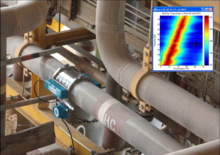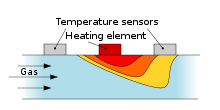In this article we will discuss about the relationship between the Volume Flow Rate and Density.
In a process industry the measurement of Flow Rate(both Mass and Volumetric Flow Rates) of a fluid is very important .If we know the density of the particular fluid then we can convert Volume Flow Rate into Mass Flow Rate of a particular pipe line and vice versa.
In some cases it is preferable to measure volumetric flow rate in comparison to mass flow rate since volume flow measuring devices are less expensive than mass flow measuring devices.
But if we know the density of the fluid we can easily convert the measured volume flow rate in terms mass flow rate as per requirement.
Volume Flow Rate is the measure of amount of any fluid passing through a flow measuring instrument per unit time. Units are litre/minute, cubic centimetres per minute etc. It is denoted by Q.
Density is the physical property of a matter which refers to the mass contained in a unit volume. Units are kilogram/cubic meter, gram/cubic meter etc. It is denoted by ρ.
Volume Flow Rate and Density relation
Density, ρ=Mass/Volume=m/V
Volume Flow Rate, Q=V/t

Where,
Q= Volume flow rate m3/s or L/s .
V=Volume of fluid in litre or cubic metre
=Average velocity of flow in m/s
( Average value is considered because at every part velocity of the fluid is not same)
A=Cross sectional area occupied by the moving fluid m2.
Hence,
Q=Cross sectional area x Average velocity
Mass Flow Rate is given by
ṁ=Mass/Time=m/t
We know that, mass=density x Volume
m=ρ.V
Multiplying both sides by t (time),
m/t= ρ.V/t=ρ.Q
Or,ṁ =ρ.Q
If we multiply density of the fluid and its volume flow rate we will get mass flow rate of the fluid. In simple words mass flow rate is density times its volume flow rate.
How to calculate Density from Volumetric Flow Rate?
Density is one of the important physical property and has influence on flow rates.
Density varies as per the type of fluid and atmospheric conditions. For example, density of cold water and hot water are different. Though oil and water both are liquid, they have vast difference in density.
Volume Flow Rate is given by
Q=V/t Eq(1)
Where, V=Volume
t=Time
Volume, V=Mass/Density
Or V=m/ρ
Substituting value of V in eq (1)
Q=m/ρ. t
ρ=m/Q . t Eq(2)
ρ=mass flow rate/volume flow rate
Density and Flow Rate
Flow Rate of a process line is the rate at which a fluid is passing through it.
Generally flow rate is expressed in terms of Mass Flow Rate(kg/min) and Volume Flow Rate(l/min). Density is the ratio of mass to volume(kg/ m3).

The relation between Density and Flow rate is given as follows:
Density,ρ=mass flow rate/volume flow rate
Density (ρ)is the mass per unit volume of a material. Fluid with high density means more number of molecules per unit volume that means more viscous or heavier and more energy is required to move the fluid resulting low velocity.
Density varies directly with pressure and inversely with temperature. Since liquids are generally incompressible in nature, therefore there is no influence of pressure on density measurement of liquid. Only change in temperature have to be considered.
Gases are compressible in nature and density of gases change with variation of temperature and pressure.
How is Density related to Flow Rate?
To control processes in an industry and to get maximum output from a process specific value of a fluid flow rate is always required.
Density is one of the physical properties of a substance which is influenced by temperature change. As the temperature increases, the kinetic energy of the molecules of the substance also increases resulting a change in density of the substance.

Different flow measuring devices are used in an industry to get accurate measurements.To get the idea of a flow rate of a fluid we should also have a knowledge of fluid density.
Density of a fluid varies with temperature, now in industrial process if the temperature changes, it leads to decrease in density of the fluid, resulting in increase in the volume. Similarly, when the temperature decreases the volumetric flow decreases due to higher fluid density.
This variation in the volumetric flow because of variation in temperature leads to inaccurate accounting and mass balance of the process. To counter the same industrial processes normally carry out a procedure called temperature compensation of flow.
In case of compressible fluids(gases), along with temperature pressure also plays a significant impact on density of the fluid. Hence for gases the compensative flow takes into account the density change with both temperature and pressure.
PV=nRT Eq(1)
Where, n=m/Mw
ρ=m/V
From Eq 1,
ρ=PMw/RT Eq(2)
- P = Pressure
- T = Temperature
- V = Volume
- Mw = Molecular Weight
- n = Number of moles
- R = Gas constant
- ρ = steam or gas density
Depending upon the various conditions we will get different outputs for design and real situations.
Using the ρRealand ρDesign formulas, we can derive the formula for real density of the process considering pressure and temperature compensation.

How does Density affect Volume Flow Rate?
The ratio of volume of a substance and its mass is known as Density ρ.
Whenever we apply heat to a liquid or gas the kinetic energy of the molecules increases due to which they cover a larger space resulting in higher volume. This implies that density is inversely proportional to the temperature.
On the other hand if pressure is applied to a body it gets compressed resulting lesser volume and higher density.
To know more about Flow Rate (Click Here)
Problems related to Flow Rate and Density
Example1: The density of the liquid is A liquid is flowing through a pipe of inner radius 6 cm with a velocity of 12m/s and the density 940 kg/m3.Determine the mass flow rate of the flow.
Solution:
Here velocity, v=12m/s, Radius of the pipe, r=6 cm, Density of liquid, ρ=940 kg/m3=
Area of the pipe=π. r2=π. 62 cm2=113.04 cm2=0.011304 m2
Volume Flow Rate= Q= v. A=12 . 0.011304=0.1356 m3/s
Mass Flow Rate, ṁ = Q . ρ=0.1356 m3/s . 940 kg/m3=127.50kg/s.
Example2: Determine the velocity of flowing water through a circular pipe. Here the inner radius of the pipe is 2cm and flow rate if water is 0. 056m3/s. Consider the density of water as ρ=998kg/m3.
Solution:
Here Radius of the pipe, r=2 cm, Flow Rate, Q=0.056m3/s, Density, ρ=998 kg/m3
Area of the pipe= π . r2 = π . 22 cm2=12.56 cm2=0.00125 m2
Mass Flow rate, ṁ=Q . ρ =0.056 m3/s . 998 kg/m3=55.88kg/s
Velocity =ṁ /ρ .A=79.3m/s

I am Sangeeta Das. I have completed my Masters in Mechanical Engineering with specialization in I.C Engine and Automobiles. I have around ten years of experience encompassing industry and academia. My area of interest includes I.C. Engines, Aerodynamics and Fluid Mechanics. You can reach me at